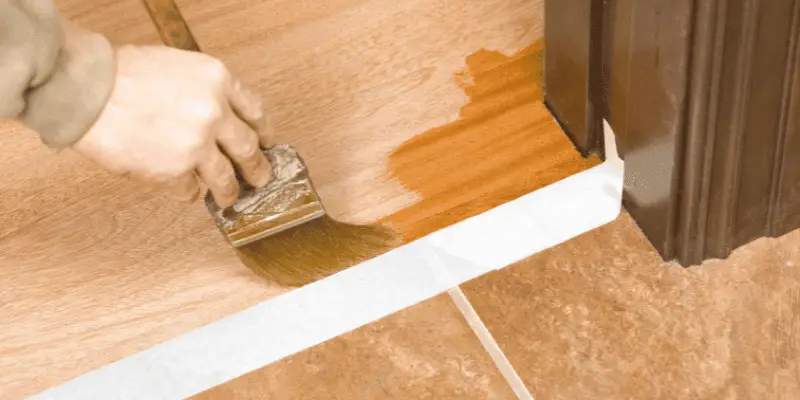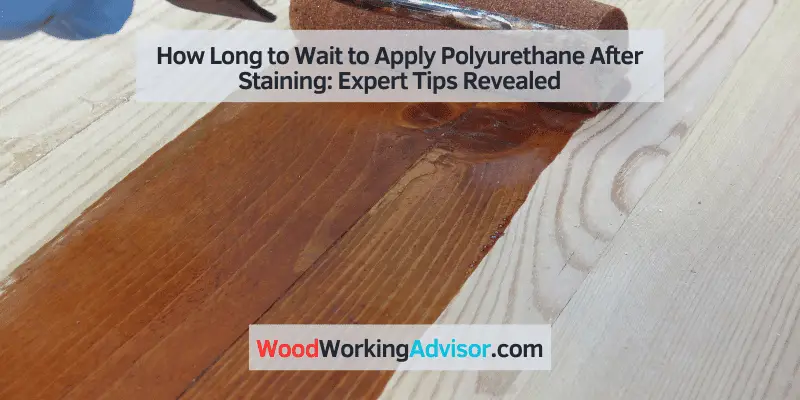You should typically wait at least 24 hours before applying polyurethane after staining. Applying polyurethane too soon may result in uneven application and poor adhesion.
Applying polyurethane after staining is an essential step to protect and enhance wooden surfaces. However, it is crucial to follow the correct timeline to ensure optimal results. After staining your wood project, it is important to let it dry completely before applying any kind of finish.
This allows the stain to fully penetrate the wood and achieve its desired color. While the drying time can vary depending on factors such as temperature and humidity, waiting at least 24 hours is generally recommended. Applying polyurethane too soon can lead to problems such as brush marks, bubbles, or peeling. Therefore, be patient and give your stained wood adequate time to dry before proceeding with polyurethane application.
Exploring The Purpose And Benefits Of Staining Wood Surfaces
Staining wood surfaces serves two main purposes. Firstly, it enhances the natural beauty of the wood, bringing out its unique characteristics. Secondly, it provides protection against wear and tear, extending the lifespan of the wood surface. When it comes to applying polyurethane after staining, it is important to wait for a specific period.
Waiting allows the stain to dry and set properly, ensuring that the polyurethane adheres effectively. The exact waiting time can vary depending on factors such as the type of stain used and environmental conditions. It is recommended to follow the manufacturer’s instructions for the specific stain and polyurethane products being used.
By waiting for the appropriate time, you can ensure that the polyurethane provides a durable and long-lasting finish over the stained wood surface.
Unveiling The Role Of Polyurethane In Wood Finishing
Polyurethane plays a vital role in wood finishing as it provides a protective barrier against wear and tear. It enhances durability and water resistance, ensuring the wood stays in good condition. Additionally, applying polyurethane gives the wood a glossy or satin finish, adding to its overall appearance.
But how long should you wait to apply polyurethane after staining? The answer depends on the specific product and manufacturer’s instructions. It is important to carefully follow the recommended drying time to achieve the best results. Waiting for the appropriate period allows the stain to fully dry and prevents any potential issues with adhesion or bubbling.
It ensures the polyurethane can be applied evenly and smoothly, creating a beautiful and long-lasting finish on your wood project.
Considering The Type Of Stain Used
When considering the type of stain used, it’s essential to analyze the oil-based stain’s characteristics. Evaluating factors such as its consistency, drying time, and the desired level of sheen is crucial. On the other hand, understanding the impact of water-based stain is equally important.
These types of stains might offer faster drying times compared to oil-based ones. However, it’s crucial to keep in mind that the drying time can be influenced by several factors, including humidity and temperature. Taking these variables into account will help determine how long to wait before applying polyurethane after staining.
Ultimately, it’s important to allow sufficient drying time to ensure a successful and long-lasting finish.
Assessing The Climate And Environmental Factors
Assessing the climate and environmental factors is crucial in determining how long to wait to apply polyurethane after staining. One key factor to consider is the effect of temperature on drying. Temperature plays a vital role in the drying process of polyurethane.
Higher temperatures tend to facilitate faster drying, while lower temperatures can significantly slow down the drying time. It is essential to ensure that the temperature is within the recommended range before applying polyurethane. Extreme temperatures, either too hot or too cold, can negatively impact the drying process and the overall quality of the finish.
Gauging the effect of temperature is necessary to prevent issues such as sticky or uneven surfaces. It is advisable to follow the manufacturer’s guidelines and consider the current climate conditions to determine the appropriate waiting time. Keeping these factors in mind will help achieve optimal results when applying polyurethane after staining.

Examining The Relative Humidity’s Influence On Staining And Polyurethane Application Process
Relative humidity greatly impacts the staining and polyurethane application process. Moisture levels have a significant effect on drying time. It is essential to understand how humidity affects each stage. Optimal humidity levels need to be identified for successful staining and polyurethane application.
Keeping moisture levels in check is crucial to achieve the desired results. Therefore, it is necessary to wait for the appropriate amount of time before applying polyurethane after staining. By ensuring the moisture levels are optimal, you can ensure a smooth application process and enhance the durability of the finish.
So, always consider the influence of relative humidity on staining and polyurethane application for best results.
Analyzing Different Wood Types And Their Drying Characteristics
Different wood types have varying drying characteristics that can affect the absorption of polyurethane after staining. Porous woods, such as pine or fir, tend to absorb stain faster but take longer to dry completely. On the other hand, dense woods like oak or cherry may take longer to absorb stain but dry quickly.
It’s important to understand the wood type you are working with and consider its drying characteristics before applying polyurethane. Take note of the manufacturer’s instructions regarding the recommended waiting time between staining and applying polyurethane. This allows the stain to fully penetrate the wood and ensures a smooth, even finish.
Waiting too long can result in poor adhesion, while not waiting enough can cause the stain to react negatively with the polyurethane, compromising the final look of your project. Remember to be patient and let the wood fully dry before applying polyurethane for the best results.
Seeking Expert Recommendations And Best Practices For Staining And Polyurethane Application
Seeking expert recommendations for staining and polyurethane application? Consultations with professionals are essential for specific project guidance. Applying polyurethane after staining depends on factors like the type of stain used, weather conditions, and the stain manufacturer’s instructions. While some stains may require immediate application, others may need a waiting period ranging from 24 hours to several days.
It is crucial to thoroughly read and follow the specific instructions provided with both the stain and polyurethane products. Factors like humidity, temperature, and drying time should also be considered to ensure proper adhesion and a durable finish. With professional advice, you can optimize the waiting time and achieve the best results for your staining and polyurethane application projects.
Conducting Sample Tests To Determine The Ideal Waiting Time
Sample response: To determine the ideal waiting time for applying polyurethane after staining, it is important to conduct sample tests. Begin by preparing several small test boards with the same staining process as your main project. Apply the polyurethane at various intervals, such as 24 hours, 48 hours, and 72 hours after staining.
Let the samples dry completely and evaluate the results. Look for differences in color, texture, and overall appearance. If the polyurethane seems too tacky or doesn’t adhere well, you may need to adjust the drying time. Take note of the optimal waiting time and apply it to your main project.
By following these step-by-step instructions and interpreting the results accurately, you can ensure a successful application of polyurethane after staining.
Precautions And Tips For Optimal Results
After staining your surface, it’s important to allow enough time for the stain to dry completely. This will ensure optimal results when you apply the polyurethane. Properly preparing the surface is essential for a smooth and even application. Be sure to sand the surface thoroughly to remove any imperfections or rough spots.
Additionally, clean the surface to remove any dust or debris that may impact the finish. By taking these precautions, you can safeguard against common pitfalls and mistakes that can occur during the application process. By following these guidelines, you can achieve a flawless finish with your polyurethane application.
Factors To Consider For Re-Coating After Polyurethane Application
Applying polyurethane after staining requires proper consideration of several factors. Determining the right time for re-coating is essential to achieve optimal results. It is crucial to evaluate factors such as humidity, temperature, and drying time recommended by the manufacturer. Waiting for the stain to fully dry and cure is crucial before applying polyurethane.
This ensures proper adhesion and prevents any issues with the finished result. Additionally, proper surface preparation is necessary to remove any dust, dirt, or imperfections that may affect the polyurethane application. Regular maintenance, such as cleaning and avoiding harsh chemicals, will prolong the lifespan of the polyurethane finish.
By carefully considering these factors and following the recommended guidelines, you can achieve a long-lasting and beautiful finish for your stained surfaces.
Innovations And Trends In Staining And Polyurethane Products
Innovations and trends in staining and polyurethane products showcase exciting new options available in the market. These advancements offer consumers a range of choices when it comes to selecting the perfect stain and polyurethane combination for their projects. By exploring new products and technologies, individuals can discover innovative solutions that can enhance the durability, appearance, and overall performance of their stained wood surfaces.
Manufacturers are continuously introducing state-of-the-art formulas designed to deliver superior results, ensuring excellent adhesion, protection against wear and tear, and long-lasting beauty. Whether you are refinishing your hardwood floors, staining a new piece of furniture, or updating your kitchen cabinets, staying informed about the latest advancements in staining and polyurethane products can help you achieve outstanding outcomes.
Stay tuned to learn more about how these new products can transform your staining and polyurethane experiences.
Frequently Asked Questions On How Long To Wait To Apply Polyurethane After Staining
How Long After Staining Can I Use Poly?
Allow a minimum of 24 to 72 hours after staining before applying poly.
When Can You Put Polyurethane Over Stained Wood?
You can apply polyurethane over stained wood after it has dried for at least 24 hours.
What Happens If You Put Polyurethane Over Wet Stain?
Applying polyurethane over wet stain results in a poor finish as it won’t adhere properly.
Can You Put Polyurethane Over the Stain Right Away?
Yes, you can apply polyurethane over stain immediately after it has dried.
Final Thought
The key to a successful polyurethane application after staining lies in patience and following the guidelines. Allow the stained surface to dry completely before applying polyurethane, typically waiting 24 to 48 hours. This ensures that the stain has thoroughly cured and won’t mix with the polyurethane, compromising the final result.
Before applying polyurethane, sanding the stained surface lightly helps create a smooth and even surface for a better finish. Be sure to remove any dust or debris before applying the polyurethane to avoid any imperfections. Applying thin and even coats of polyurethane is crucial to preventing drips or brush marks.
Remember to let each coat dry according to the manufacturer’s instructions before applying another. Following these steps will ensure a beautifully stained and protected surface that will stand the test of time.



6 thoughts on “How Long to Wait to Apply Polyurethane After Staining: Expert Tips Revealed”